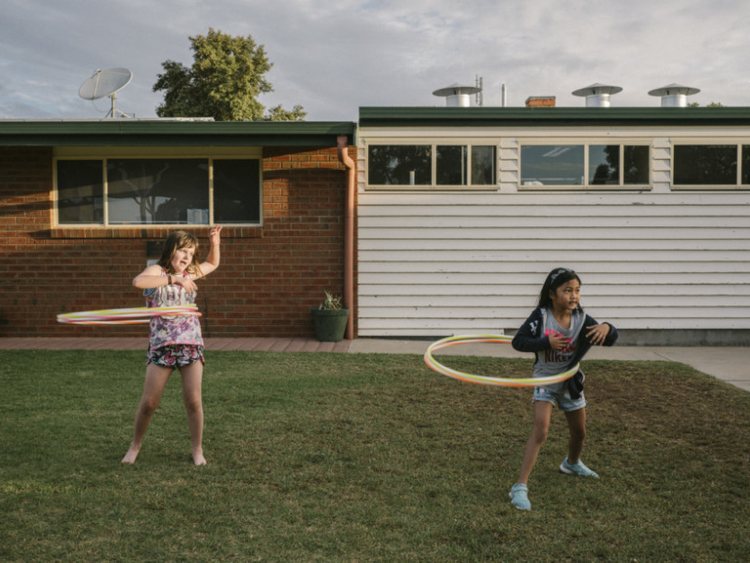
PYRAMID HILL, Australia
A lanky Filipina girl with long black hair stood at the wickets behind St. Patrick’s School, waiting for a pitch from a burly dad with a reddish beard.
The cricket ball came in slow. Her swing was quick as a bee’s wing, sending the ball skyward as a gaggle of kids — mostly Filipino, some white — cheered and elbowed to bat next.
The game, played on a recent afternoon, was a typical mixed gathering for Pyramid Hill, a one-pub town of around 500 people in central Victoria that has become a model of rural revival and multicultural integration.
“I’m still surprised they’re as open to us as they are,” said Abigail Umali, 39, a veterinarian from Manila who works at a local farm, and whose daughter, Maria, was the girl at bat.
“This school wouldn’t be here if it wasn’t for them,” said Kelvin Matthews, 36, the pitcher, as he watched the children interact.
Filipinos now make up nearly a quarter of Pyramid Hill’s growing population. New homes are going up here for the first time in a generation — and both the newcomers and lifelong residents say they have found the answer to rising concerns about immigrants straining resources in Australian cities. It’s called small-town living.
A need to mix
“People in the country mix, and need to mix,” said Tom Smith, a farmer who inadvertently started the town’s revival in 2008 when he sponsored visas for four workers from the Philippines. “It’s just different out here; it’s the only way to survive.”
Rural collapse is a familiar tale, seen across the American Midwest and in many areas of Europe, where small communities have been squeezed by globalisation. It’s no different in Australia: an urbanising country, as physically large as the United States, where towns of a few hundred people are fading like puddles in the sun.
But the success of Pyramid Hill — and many other small Australian towns — suggests there are opportunities being missed and lessons to be learnt. At a time when politicians in Australia, and around the world, are calling for restrictions on immigration, small towns in Australia are asking for more immigrants.
“There’s a real network of people who know how to make this work, who make it work in their community and can share it with others,” said Jack Archer, chief executive of the Regional Australia Institute, a government research organisation. “This is something we should really be thinking about scaling up.”
25%
|
Pyramid Hill is a quiet drive of about 240 kilometres (150 miles) from Melbourne, finishing with a stretch of land that is mostly empty except for golden wheat fields and lint-grey sheep.
The community took its name in 1836 from a granite outcrop on the town’s edge. From its peak, I had little trouble seeing newer landmarks, which rose above the countryside and hinted at local despair: grain silos that are no longer used; a pet food factory that shut down in 2008.
Residents still talk about the era before the Filipinos came as one of quiet desperation. Streets without children. Homes decaying. The town’s population bottomed out at 419 in 2011, down from 699 in the 1960s.
“We were in dire straits,” said Cheryl McKinnon, the mayor of Loddon Shire, the municipality that includes Pyramid Hill. “We needed our population to grow.”
Economists often discuss immigration in terms of a multiplier effect. Newcomers do not just fill jobs, they also create them, by bringing demand for new products and services.
This is especially true in Australia, where the minimum wage is 18.29 Australian dollars an hour (Dh50.30) and most migrants are skilled workers or students.
“Australia’s focus on skilled migration has demonstrated positive effects for economic growth,” a recently published government report on population growth found, “because our migrants on average lift potential GDP and GDP per capita.”
In many cities and suburbs, though, population growth has brought frustration. Melbourne added 125,000 people during the last fiscal year, its largest recorded increase, and Sydney added 102,000. In both cities, immigration was the primary cause, prompting complaints about housing, crowded schools and traffic.
The government of Prime Minister Malcolm Turnbull has responded to such concerns by restricting immigration: maintaining harsh offshore detention centers for asylum seekers and limiting the number of skilled-worker visas.
Places like Pyramid Hill offer an alternative.
BOX
Families bring energy
Compared with those in many cities and suburbs, people in Pyramid Hill seem to have more time and interest in building bonds across ethnic boundaries. An annual Filipino “fiesta” was added to the town’s events calendar in 2015, and every week seems to include an opportunity to socialise.A short walk away from the cricket match at St. Patrick’s, for example, teenagers gathered for a trivia night at Pyramid Hill College, the public school where Garchitorena works.
The town has welcomed the Filipinos in part because families bring energy. But it also helps that, like the locals, many are Catholic, and they arrived in Australia speaking some English.
“We’re trying to mesh together,” said Garchitorena’s daughter, Fionne, 15. “I think it mostly works.”
Still, she said, there are growing pains. “It’s like when I have rice for lunch and they’ll say ‘You’re so Asian’ - and I’m like, well, yes, I’m very aware of that.’”
Duke Caburnay, 16, whose father works at Kia-Ora, said he runs up against racism when his team plays Australian rules football in other small towns. White players sometimes hurl racial insults at him.
Some of Pyramid Hill’s adult Filipino residents also say they are expected to outperform white counterparts just to be considered equal.
“They generalise a lot - Asians are like this, Australians are like that,” said Fritzie Caburnay, 46, Duke’s mother, who has a master’s degree in public administration.
Still, she said, “we feel at home here.”
It’s a sentiment widely shared.
New York Times News Service













